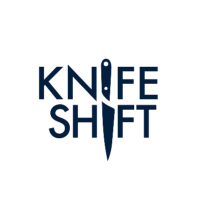Sort by:
About the Artwork:
Save Waste Fats (Artist Unknown, c. 1943) is a World War II propaganda poster aimed to mobilize civilians on the home front. This utilitarian poster serves an instructive function, providing civilians with direction on how to recycle essential resources that can be used in the war effort.
Image courtesy of Boston Public Library Digital Commonwealth Collections.



Food is: Propaganda | Unisex T-Shirt - Little Americans, Do Your Bit
$34.99
Unit price perFood is: Propaganda | Unisex T-Shirt - Little Americans, Do Your Bit
$34.99
Unit price perAbout the Artwork:
Cushman Parker (1915-1991) was an Austrian-born American painter and graphic designer best known for his work during the mid-20th century. Parker was recruited by the U.S. Food Administration during World War I. Posters like "Little Americans, Do Your Bit" were part of a nationwide campaign mobilizing everyday citizens, including children, to contribute to the war effort in unexpected ways.
This poster features a young boy dressed in patriotic red, white, and blue raising his right hand in a salute. His gaze is fixed on a bowl of oatmeal in front of him, a spoon held mid-air. The text reads, "Little Americans, Do Your Bit: Eat Oatmeal, Corn Meal Mush, [...] Save the Wheat for Our Soldiers" in bold letters around the image. The final line reads, "Leave Nothing on Your Plate."
Image courtesy of the Library of Congress, Washington.
About the Artwork:
Dick Williams (1908-1981) was an American commercial illustrator whose work flourished during the mid-20th century. While details about his career are somewhat scarce, his contributions to the war effort stand out. Williams created illustrations for various publications, but his impactful posters for the U.S. Department of Agriculture (USDA) like "Of Course I Can!" played a vital role in boosting morale and promoting resourcefulness on the home front during World War II.
This colorful poster features a bright-eyed woman in a checkered dress and apron. She carries an armful of jars of colorful fruits and vegetables. Her enthusiastic expression and determined stance communicate a sense of can-do spirit. The bold text "Of Course I Can! I'm as Patriotic as Can Be – And Ration Points Won't Worry Me!" completes the poster.
"Of Course I Can!" celebrates the essential contributions of civilians during World War II presenting food preservation as a form of patriotic duty.
Image courtesy of Boston Public Library Digital Commonwealth Collections.

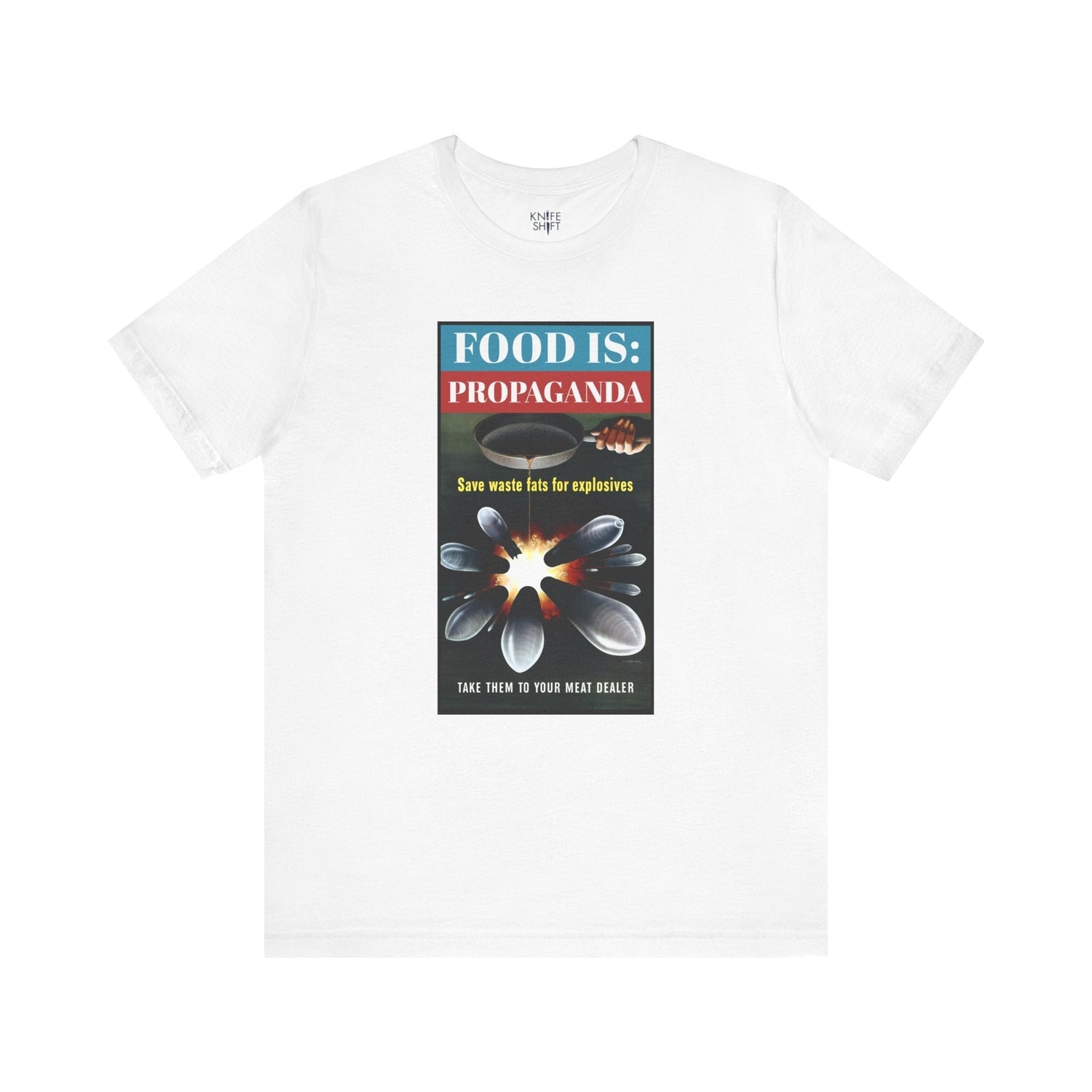
Food is: Propaganda | Unisex T-Shirt - Save Waste Fats for Explosives
$34.99
Unit price perFood is: Propaganda | Unisex T-Shirt - Save Waste Fats for Explosives
$34.99
Unit price perAbout the Artwork:
Henry Koerner (1915-1991) was an Austrian-born American painter and graphic designer best known for his work during the mid-20th century. Koerner's artistic talents found a critical outlet during World War II when he was recruited by the U.S. Office of War Information. Posters like "Save Waste Fats for Explosives" were part of a nationwide campaign mobilizing everyday citizens to contribute to the war effort in unexpected ways.
This dramatic poster features a powerful visual metaphor. A woman's hand, illuminated from below, pours grease from a skillet directly into a fiery explosion. Shrapnel and bomb casings erupt from the center, symbolizing the transformative power of recycled fat. The stark black background intensifies the imagery. The text "Save Waste Fats for Explosives. Take Them to Your Meat Dealer" appears in bold white lettering at the top and bottom, delivering a clear call to action.
Image courtesy of Boston Public Library Digital Commonwealth Collections.
About the Artwork:
Charles Edward Chambers (1883-1941) was an American illustrator who rose to prominence during the Golden Age of American illustration. He created iconic imagery for brands and publications, but his contributions to the U.S. war effort during World War I hold particular significance. Chambers' bold and graphic style translated perfectly to wartime propaganda posters, like "Food Will Win the War," which aimed to mobilize the American public.
This poster features a group of immigrants arriving in New York Harbor, gazing up at the Statue of Liberty. They are diverse in ethnicity and dress, symbolizing the melting pot of America. The Statue of Liberty, a beacon of freedom, stands proudly in the background, bathed in a hopeful rainbow. The text at the top reads "Food Will Win the War. Wheat is Needed for the Allies," while a caption below pleads "You came here seeking freedom. Now you must help to preserve it. Waste nothing."
While the message of conserving wheat to aid the Allies is clear, the referenced American population of immigrants adds a layer of complexity. These new Americans, seeking a better life, are presented as having a stake in the war effort. The Statue of Liberty, a symbol of freedom and opportunity, reinforces the idea that preserving democracy requires a collective sacrifice.
Image courtesy of Boston Public Library, Digital Commonwealth Collections.
About the Artwork:
Herbert Bayer (1900-1985) was an Austrian-born American graphic designer, painter, and photographer. A pioneer of the Bauhaus movement, Bayer was known for his clean, geometric style and focus on functionality. During World War II, he lent his talents to the U.S. Department of Agriculture (USDA), creating impactful posters like "Our Allies Need Eggs" to mobilize American farmers.
In the foreground of the poster, a giant, white egg is featured. The egg contrasts sharply with the background scene of a burning cityscape. Flames lick at the buildings, casting a glow on the smoke-filled sky. The text "Our Allies Need Eggs. Your Farm Can Help" appears in bold lettering.
The poster encourages increased egg production by demonstrating the devastation faced by America's allies during World War II. It serves to highlight the essential role played by American agriculture in supporting the war effort and to call on farmers to be unwavering in their patriotism and contribute to those fighting for freedom overseas.
Image courtesy of the U.S. Library of Congress.

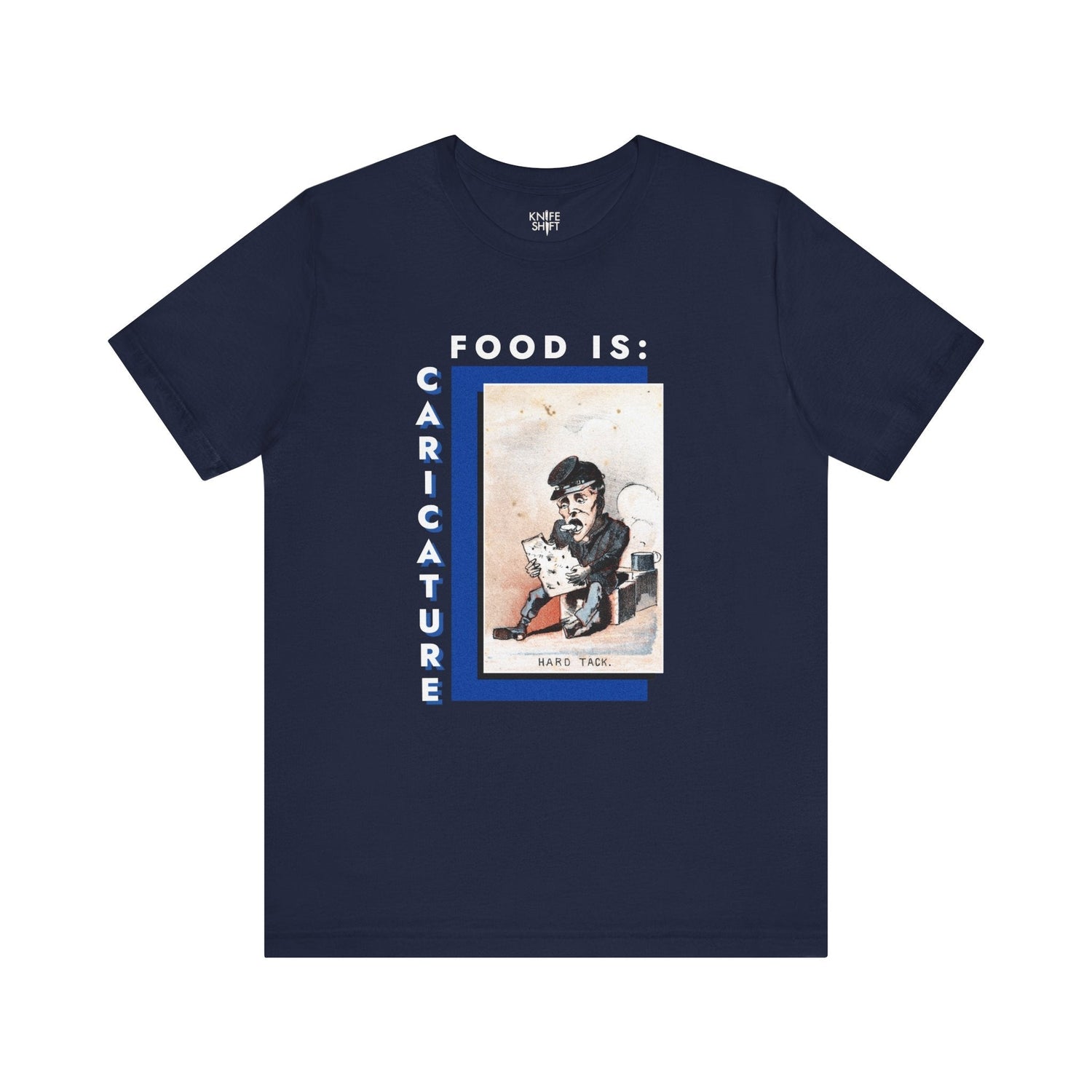
Food is: Caricature | Unisex T-Shirt - Soldier with Hard Tack
$34.99
Unit price perFood is: Caricature | Unisex T-Shirt - Soldier with Hard Tack
$34.99
Unit price perAbout the Artwork:
Winslow Homer, born in 1836 in Boston, Massachusetts, stands as one of the titans of 19th-century American art, known for his vivid and detailed portrayals of American life and landscapes. He began his artistic career as a commercial illustrator, and his experience as a wartime correspondent during the Civil War profoundly influenced his later works. Homer is celebrated for his powerful depictions of nature and human endurance, often highlighting the interplay of human figures within expansive landscapes, using both oil and watercolor to stunning effect.
In 1864, Winslow Homer created lithographed collector's cards called "Life in Camp." In these works, Homer employed a humorous tone to engage in small reflections on military life. This image captures a Union soldier's grimace in reaction to hard tack, a widely disliked basic ration that was a necessary source of nutrition during the war.
Image courtesy of the Met's Open Access Initiative.
About the Artwork:
This advertisement card printed in the United States in 1887 is a chromolithograph that features one man and two women with the bodies of red radishes. The image is meant to be humorous and eye-catching, and served as a calling card for Rice's Seeds to promote a variety of globe radishes.
Image courtesy of Boston Public Library via the Digital Commonwealth Collection.

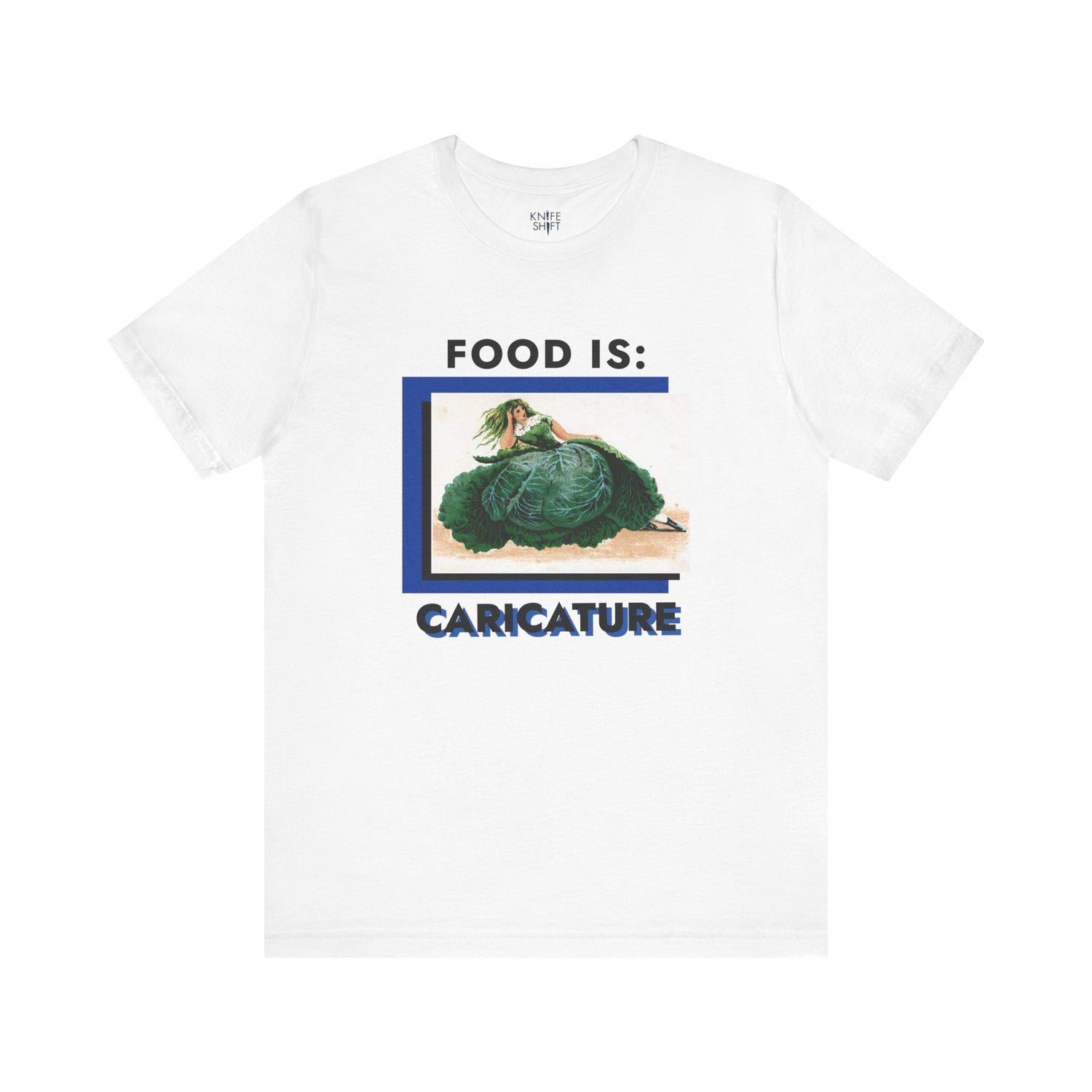
Food is: Caricature | Unisex T-Shirt - Woman in Cabbage Dress
$34.99
Unit price perFood is: Caricature | Unisex T-Shirt - Woman in Cabbage Dress
$34.99
Unit price perAbout the Artwork:
The artwork pictured isn't attributed to a specific artist, but rather to the print shop Clay & Richmond, operating in Buffalo, New York during the mid to late 19th century. This company was known for producing quirky and often humorous chromolithographs, a type of colorful lithograph print.
The chromolithograph itself depicts a curious sight: a woman with an elegant posture leans confidently towards the viewer. Her unique gown, however, is the real showstopper. Instead of luxurious fabrics, she is adorned in a dress entirely fashioned from a single, vibrant green cabbage. The artist renders the ruffled leaves, creating an elegant ensemble.
Image courtesy of Boston Public Library via the Digital Commonwealth Collection.

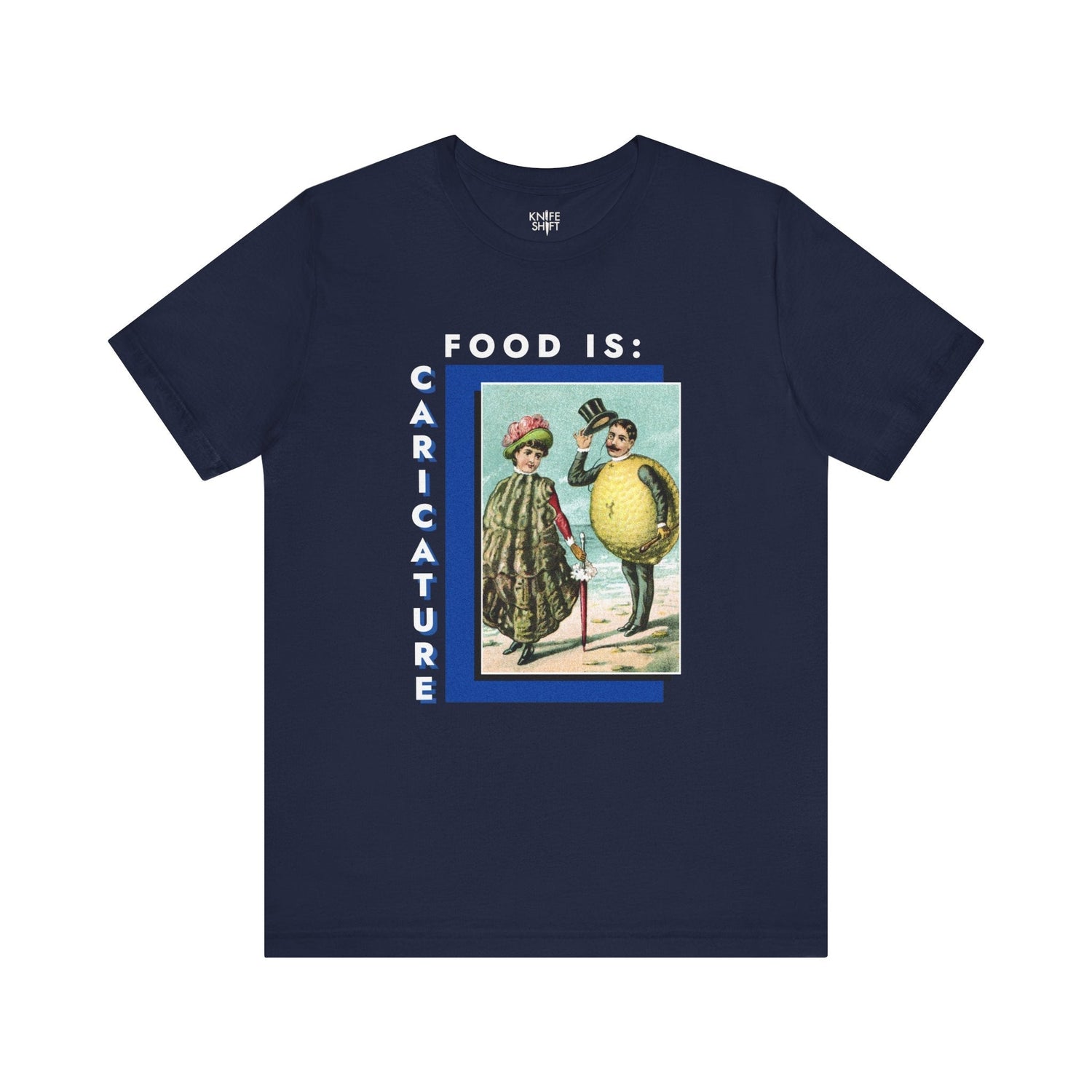
Food is: Caricature | Unisex T-Shirt - Lemon and Oyster Personas
$34.99
Unit price perFood is: Caricature | Unisex T-Shirt - Lemon and Oyster Personas
$34.99
Unit price perAbout the Artwork:
The Buffords Sons Lith. Co. was a prominent American lithography firm based in Boston, operating with influence throughout the 19th century. Founded by John Henry Bufford, a key figure in the development of American lithography, the company was known for its high-quality prints, illustrations, and posters. Their work often included vibrant and detailed images that catered to a wide range of commercial and artistic needs, capturing the cultural and social nuances of American life during that era. Their contribution to the lithographic arts is notable for both technical innovation and the popularization of artistic prints.
"Miss Shell and Mr. Lemon" features anthropomorphic representations of an oyster shell and a lemon in a playful, possibly romantic interaction. Miss Shell is elegantly and delicately detailed while Mr. Lemon is depicted with a zestful and bright appearance, enhancing his citrus character.
Public domain image courtesy of Cornell University Library Digital Collections, modified.
About the Artwork:
Honoré Daumier, born in 1808 in Marseille, France, was a prolific and influential French artist known for his caricatures, paintings, and sculptures that keenly critiqued the social and political atmosphere of 19th-century France. Daumier's work, often published in periodicals such as La Caricature and Le Charivari, employed humor and satire to expose the follies and injustices of his time. His sharp wit and insightful portrayals have made him one of the most respected figures in the realm of political and social commentary through art.
This artwork is a lithograph that showcases Daumier’s unique blend of satire and visual narrative. "The king of pumpkins receiving the homage of his subjects" presents a scene where a large, round man and his partner survey various autumnal produce, including pumpkins. Daumier references pumpkins and the depiction of the large bodied people to create a scenario of a regal couple presiding over their subjects.
Image courtesy of the Met's Open Access Initiative.

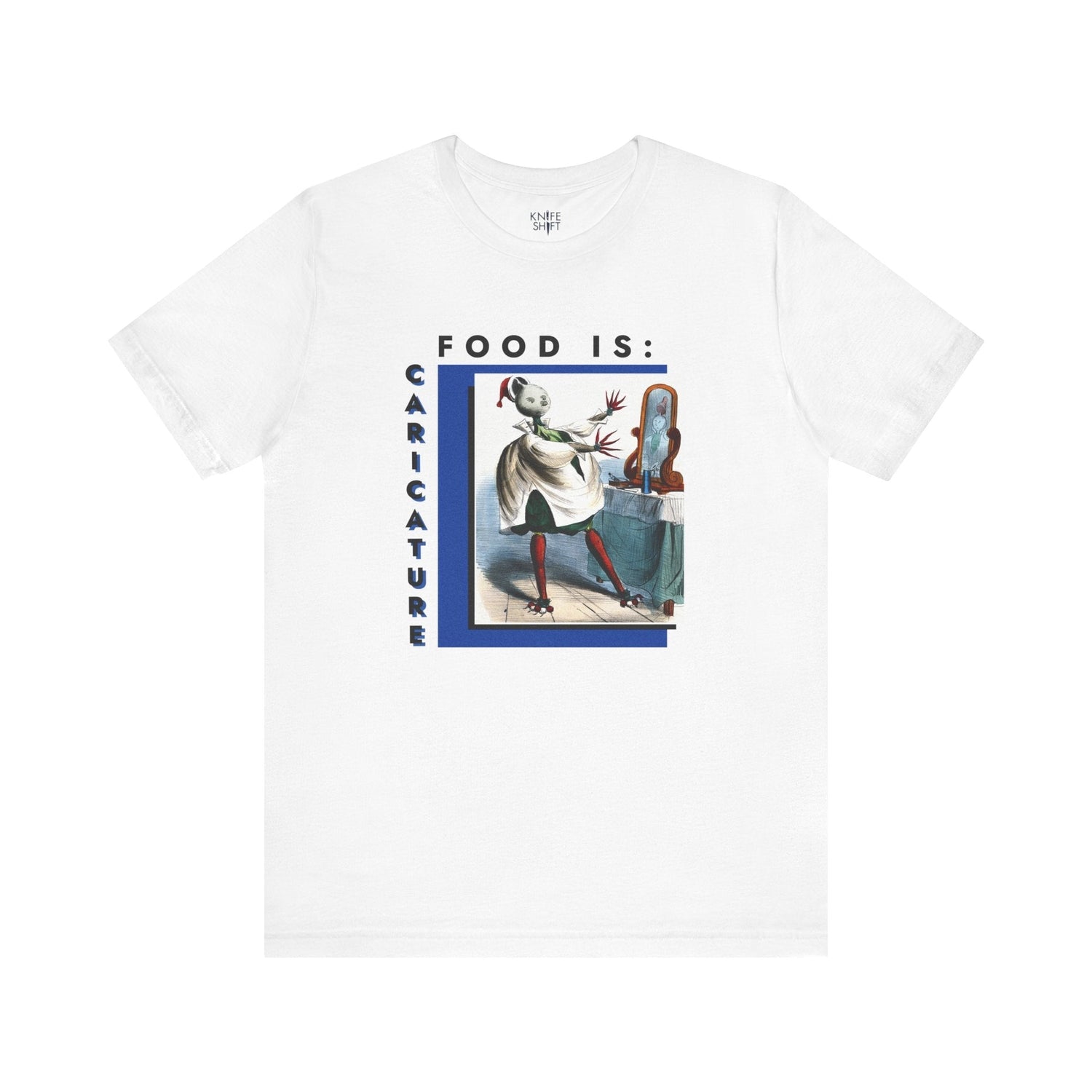
Food is: Caricature | Unisex T-Shirt - Vegetable Pill Effects
$34.99
Unit price perFood is: Caricature | Unisex T-Shirt - Vegetable Pill Effects
$34.99
Unit price perAbout the Artwork:
This satirical print, titled "Wonderful Effects of Morrisons Vegetable Pills" and published by O'Hodgson in London, offers a humorous critique of 19th-century patent medicines. This was a period when unregulated "cure-alls," often with dubious ingredients, were widely advertised and consumed with promises of extraordinary results.
The image presents a chaotic scene. A figure, overwhelmed after consuming an excessive quantity of "Morrisons Vegetable Pills," gazes into a mirror. To their horror, their body has sprouted a bizarre profusion of vegetables: carrots, turnips, radishes, and various greens.
"Wonderful Effects of Morrisons Vegetable Pills" exaggerates the outlandish claims often made by patent medicine manufacturers. The sprouting vegetables mock the idea that a simple pill could bring about drastic physical transformation. The print cleverly exploits the connection between food and medicine to highlight the potential dangers of unregulated substances and the gullibility of the public.
Image courtesy of the National Library of Medicine Digital Collections.
